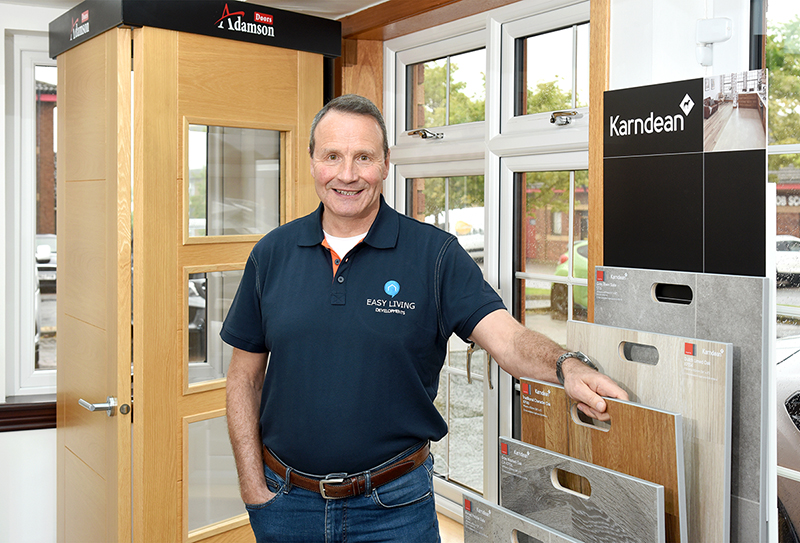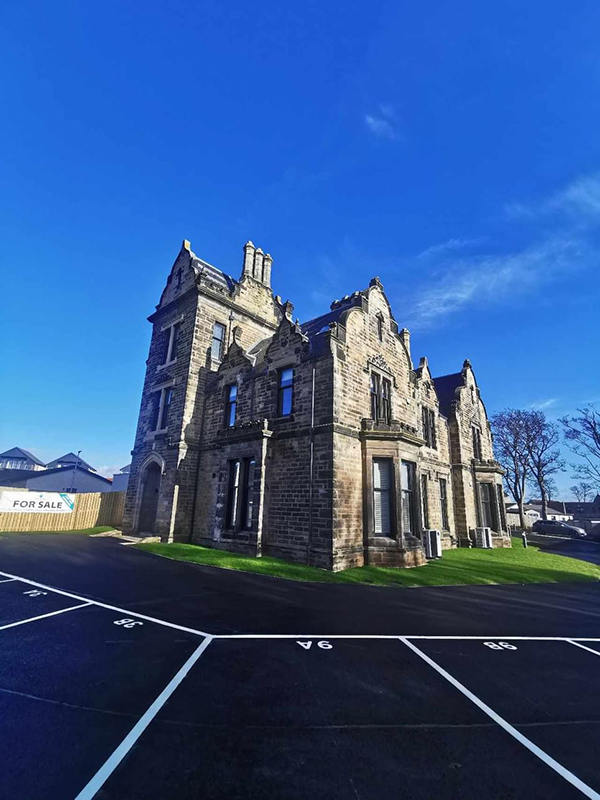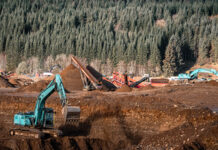
GLENROTHES-based Easy Living Homes is helping to address Scotland’s housing crisis, with work gathering pace at the firm’s latest 80-home development in the village of Coaltown of Balgonie.
The site, which is already 25% sold out, will be completely gas-free thanks to the use of ground source heat pumps and follows the success of the company’s developments in East Wemyss, Kirkcaldy, and Lochgelly.
Easy Living Homes is the housebuilding division of parent company Easy Living Developments, a construction business founded in 2011 by entrepreneur Keith Davidson and his wife Tracey, an accountant from Kirkcaldy.
Keith’s journey to becoming a leading property developer has been fascinating to say the least. Born in London, he joined the Royal Navy at 16 to be an electrician and rose through the ranks to become an officer. He ended up second in command of a minesweeper warship based at Rosyth.
Following 12 years in the Navy, Keith and Tracey set up a business retailing nappies called Tops for Bottoms. The venture was going great guns for six months and Keith had visions of it becoming a national franchise before, as he put it, the ‘bottom fell out the market’ after a major toy retailer started selling huge packs of nappies for cheaper than he was able to buy them.
Keith moved into financial services before setting up an insurance/advisory company. After selling that business, he started investing in coal mines and bought two mines – one in Wales and one in the Midlands – which were eventually sold to Waverley Mining. Keith also bought a quarrying business which he modestly admits ‘did rather well’.
He was headhunted by Hong Kong-based conglomerate Chyau Fwu Group and became their European and America CEO. The business had a diverse range of investments, with interests in everything from pet food and military vehicles to hotels and sports cars.
Keith left the business in 2011 and had one eye on retirement before he and Tracey decided to set up a construction business.
“We built a holiday home in Pitlochry but never lived in it,” Keith told Project Scotland. “We sold it the day we finished construction to a lady in the street who happened to be passing and asked if it was for sale!”
The first major initiative Easy Living Developments embarked upon was for the build of commercial units in Glenrothes. Using timber frame construction, the firm built an Iceland store. So impressed was the supermarket chain that Keith was asked if the company would build more stores throughout the UK, but he declined as he wanted to remain Fife-centric.
A landmark project followed in Glenrothes town centre, where the business completed a retail development that brought Marks & Spencer to the town along with Farmfoods, an Iceland food warehouse, and a tanning salon.
As part of that deal, the local miners club which occupied the site was relocated in a move which Keith said has resulted in ‘possibly the best working people’s club in Scotland’.
“The club had two-and-a-half-acres of land they leased off Fife Council,” Keith explained. “There was a bowling green out the back and a large car park. The club was literally failing down, and the members wanted us to buy the land and relocate them to an enhanced and more practical facility. We had to do a deal with both the club and the council to acquire the land. In return we bought from the council the old social work offices at the northern end of Glenrothes and converted them into what is possibly the best working people’s club in Scotland! It has a 550-seat auditorium, snooker rooms, a smaller auditorium, cooking facilities, and a bar.”
The retail park was sold to Liverpool-based property investment and development specialist Atmore Group. Atmore subsequently became interested in getting involved in residential projects and teamed up with Easy Living with a new Joint Venture Company called Atmore Easy Living Developments (AELD), a firm which buys land for Easy Living to develop.
A major milestone in the evolution of Easy Living was the arrival of Technical Director Scott McKechnie in 2013, who joined from his own successful architectural and development business, having previously been the Technical Director of Lomond Homes which he left a couple of years prior to the company’s demise.
“His speciality was timber frame buildings,” Keith added. “We expanded and delivered luxury one-off housing projects from Kingsbarns in the east of Fife to Kelty in the west and everywhere in-between.
“Our first major residential development was Lochgelly, where we built 168 houses. Unbeknown to us, there was mine workings underneath we had to deal with, and part-way through the development Scottish Water came along and said the existing water main was failing and therefore they could not provide sufficient water for the development until the installation of a new water main. It was certainly an initiation by fire into the world of larger scale housebuilding but, to be fair, we bought the land at the right price and did alright as it turned out.
“Other developments we’ve just finished include the former Forth Park Maternity Hospital site in Kirkcaldy. It had a listed mansion and stable block, both of which were very dilapidated. We had to retain them and the old hospital building itself, which contained asbestos. Again, we found unrecorded mine workings underneath.”
The Forth Park development was further complicated by the fact construction took place during the pandemic, but ultimately delivered 55 residential units, the last of which was occupied earlier this year.
A further development of 100 units, the majority of which are bungalows, is nearing completion at East Wemyss, a village on the south coast of Fife, where only 11 homes remained unsold at the time of interview.

Next on the agenda is a site at Cupar Muir, which will be an over-55s development comprising of around 50 lodges.
“The reason we’re going for lodges is because the site has some interesting ground conditions so rather than implement an expensive piling system to create the foundations for two-storey houses, we have decided to employ large re-enforced concreate pads on which the lodges can sit. The additional benefit here is that by employing far less intrusive site measures we are creating a more sustainable development.”
Further projects are in the pipeline, including plans for 114 luxury holiday lodges at the former Devonshaw quarry near Powmill in Perth and Kinross.
“We bought the old quarry some years ago at an auction,” Keith said. “It closed in the late 1970s but it’s the most beautiful site I’ve ever come across. It’s taken us three or four years to get through the planning system, however by actively working with Perth & Kinross Council, we now have planning permission for what will hopefully become a fantastic holiday destination and even a wedding venue that is within 90-minute traveling time of 90% of Scotland’s population. This venture also has a joint venture partner in Auchterarder-based DQSL Limited and together we formed the new company ‘Devonshaw Leisure Ltd’ to take this exciting project forward.”
One of the house-types Easy Living specialises in are two-bedroom bungalows. Because bungalows tend to be ‘land-hungry’, they’re a rarity on new-build sites. However, the demand is there, primarily from downsizers.
Sustainability is also high on the agenda, with Easy Living committed to building properties that incorporate environmentally-friendly measures and help occupiers save money on energy bills.

“We were one of the first companies in the modern era to undertake reasonable-sized developments without gas,” Keith stated. “That was at Forth Park, where it’s all air source heat pumps. At Coaltown of Balgonie, we’re also one of the first companies to do a reasonable-size scale of 80 units using ground source heat pumps.
“We’re also using far more recycled materials than we ever did before in a concerted effort to be more environmentally-conscious.”
While Keith concedes there is still a lot of ‘Nimby (Not In My Back Yard)ism around, he is confident that new housing can help rejuvenate communities and bring a raft of benefits.
Easy Living primarily works with a local supply chain, including some SME businesses which have grown in tandem with the company. The firm has become an important employer in Fife, with its own in-house technical team and around 40 ground workers directly employed.
Keith is relaxed about future expansion, revealing that any growth will be ‘steady’.
“We’ve reached the stage where we like to do 50-80 units a year,” he said. “Any more than that would mean we’d have to grow internally quite a bit. We’d need to relocate from this office as we’d need more sales and backroom staff.
“You then look at (potentially) buying our own diggers instead of hiring them. To do that you ned a facility to keep them and maintain them (and) we’d need fitters.
“We like being Fife-centric. We pick and choose where we want to be and where we think our quality homes will sell. Hopefully we’ve found a sweet spot. To make that sweet spot sweeter, we’d have to grow and expand and we’re not quite ready for that, but there’s potential for that in the future.”










